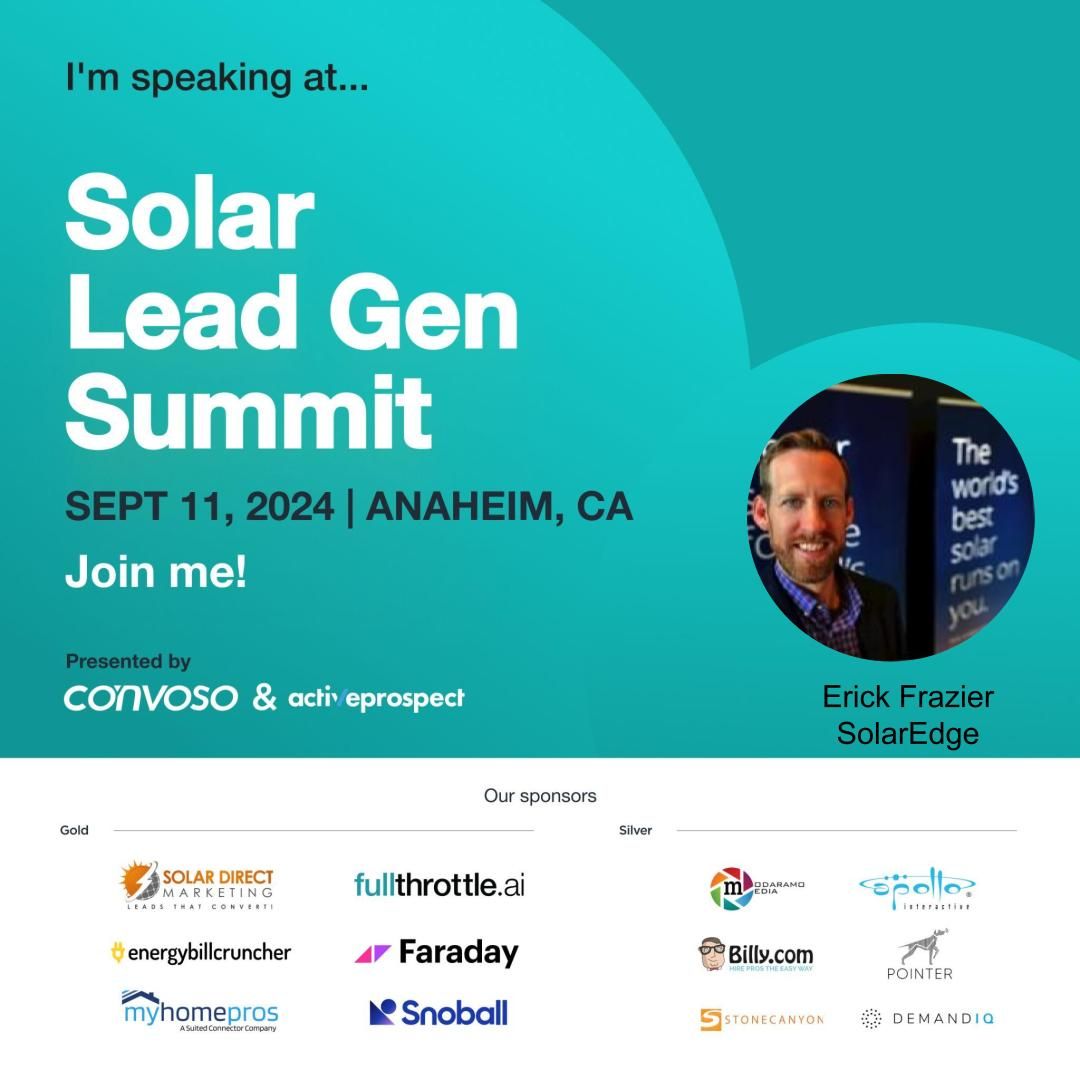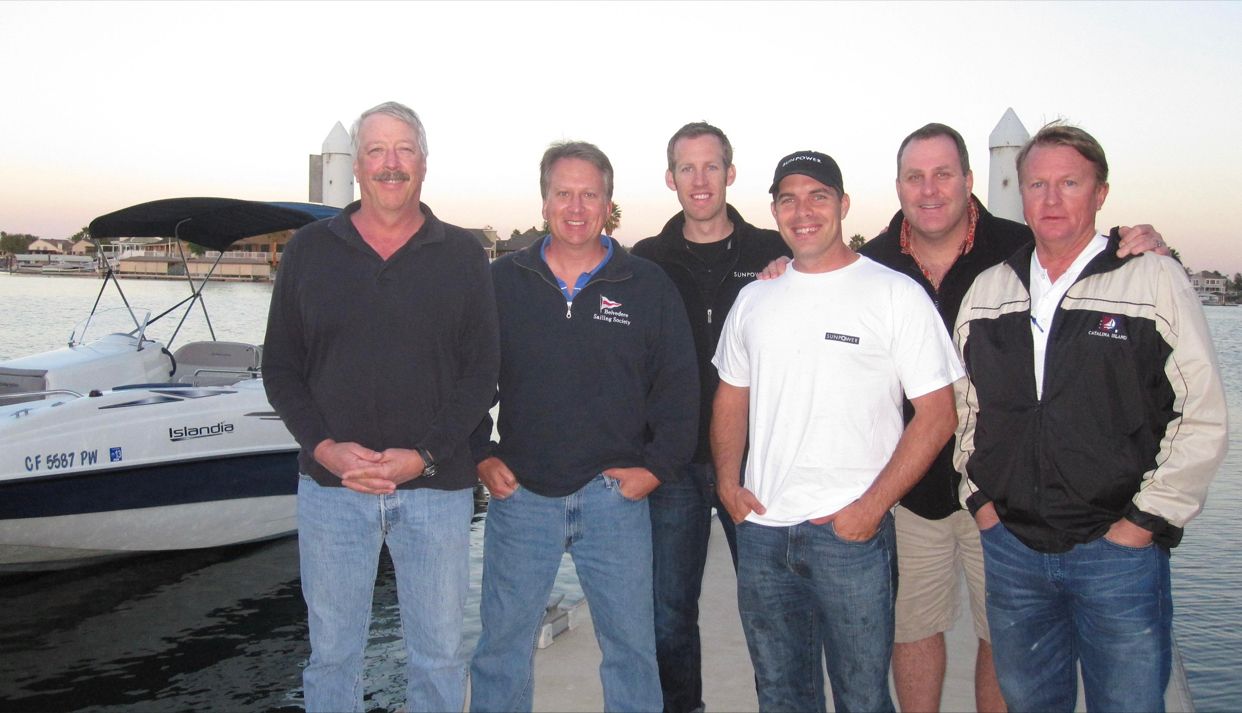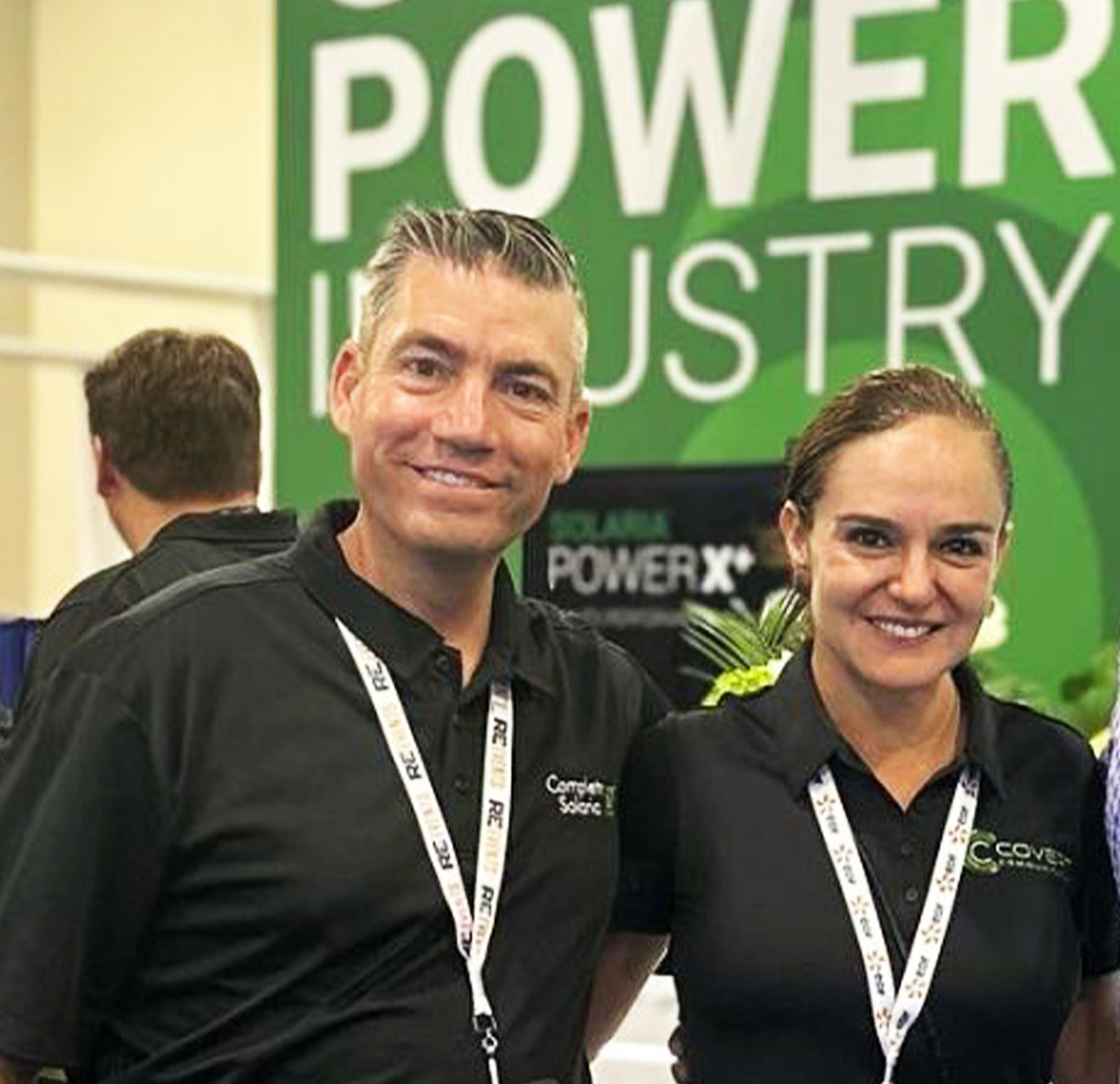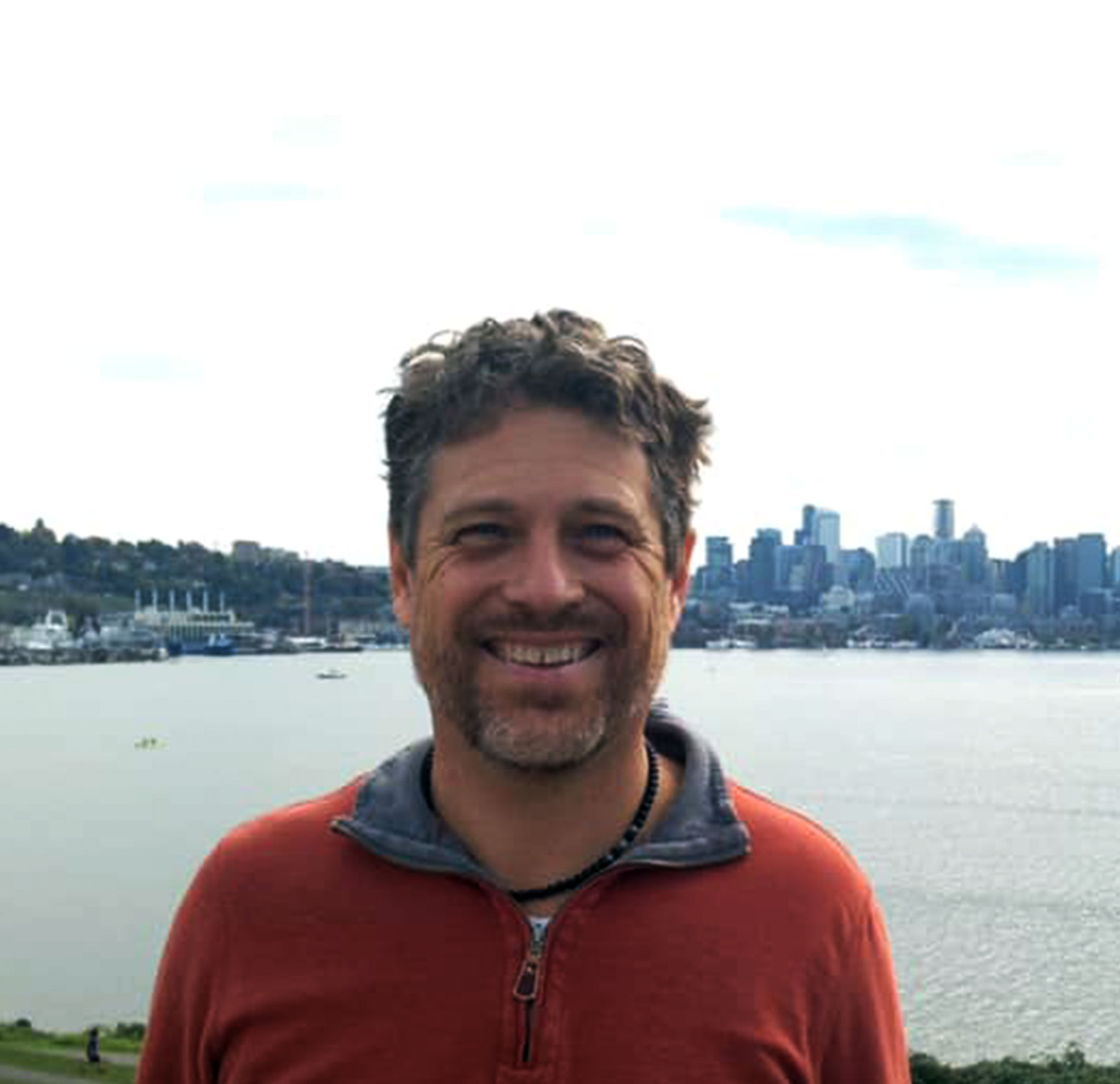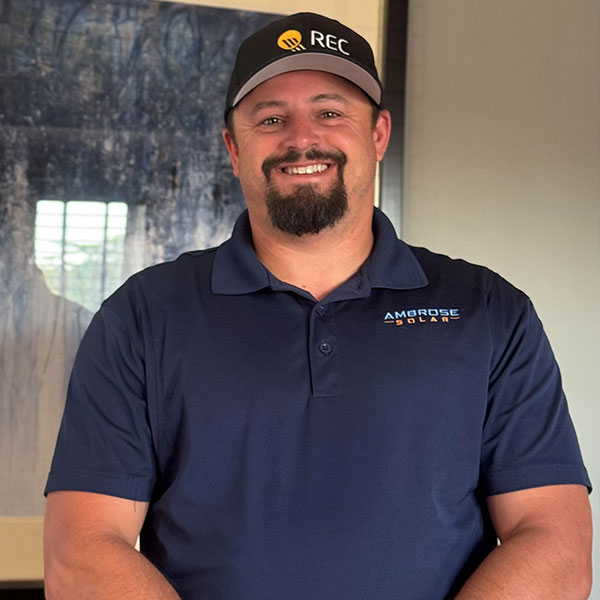Building the Blueprint for Manufacturer-Led Growth
How to Build a Lead Engine That Scales
Getting leads has always been the first—and most persistent—problem for solar dealers. If you want to understand what it takes to solve that problem at scale, Erick Frazier is the person to learn from. I first met Erick during his rise at SunPower, where he advanced to Director of Demand Generation and played a key role in building one of the most successful dealer-driven lead engines in residential solar.
He didn’t stop there. At SolarEdge, Erick built the manufacturer’s first-ever lead program in under a year—creating the digital infrastructure, routing logic, and dealer systems from scratch. It was fast, focused, and foundational.
Now? He’s joined Tesla. Details are still under wraps, but if history is any indication, whatever he’s building next will raise the bar again!
I sat down with Erick to unpack exactly how he’s built these programs from the ground up, what most manufacturers get wrong about lead generation, and what it really takes to create a system that scales.
CASE STUDY: Building the Blueprint for Manufacturer-Led Growth
Anna: Erick, you’ve been in solar for a long time—but you didn’t start there. What brought you into the industry?
Erick: I was living in China, surrounded by smog, and thought, I don’t want the U.S. to end up like this. I started researching renewables—wind, geothermal, even podcasts—and eventually landed on solar.
When I got back to the States, I moved to Texas and was so eager to break into the industry that I offered to work for free. That got me into Meridian Solar, where I did everything from residential sales to commercial bids. It was hands-on and fast-paced—and it introduced me to SunPower.
Later, I moved to Denver, joined Namasté Solar, and really honed my skills in residential sales. When SunPower opened up a Regional Sales Manager role for the Mountain West, I jumped at the opportunity. I already knew the product, and now I had the experience to back it up.
Anna: You stepped into that Regional Sales Manager role at a pivotal time. What were you stepping into, and how did the idea for the Master Dealer program first take shape?
Erick: The industry was still young, but SunPower was ready to level up. The challenge we kept running into was scale. We had this incredible brand and product, but solar was still being sold and installed by hundreds of small, local businesses across the country. That fragmentation made it tough to build a consistent national presence.
That’s where the idea for the “SunPower by” Master Dealer program came in. We asked ourselves, what if we could bring brand unity to the field—without owning the whole sales channel? The goal was to create a top-tier group of dealers who could carry the SunPower name as part of their own. But asking someone to give up their brand identity is no small thing—it’s emotional. So, we had to build real value: exclusive access to products, priority support, co-op marketing funds, a VIP hotline, and more.
It started as a pilot with just a few dealers—and by the end, just 8% of our SunPower Dealer partners were doing over 50% of the residential volume as our Master Dealer Channel. It turned into one of the most impactful programs I worked on.
Anna: Once the Master Dealer program was in motion, what became the next big focus? What were you seeing in the field?
Erick: Even with the dealer network thriving, one problem never went away: customer acquisition. Every installer was asking the same question—How do I get more qualified leads? We realized SunPower had something unique—a national footprint and the ability to drive demand at scale.
At first, we sent leads out for free. We thought dealers would jump on them, but the reality was, without skin in the game, follow-up was inconsistent. So, we started charging—$25 per lead, then $35. That helped create buy-in, but we knew there was a bigger opportunity if we could go further down the funnel. So, we started building out an internal call center to book appointments on behalf of the dealers. That’s when things really started to click.
Anna: So, while the Master Dealer program was taking off, SunPower was also exploring a different path—building a direct-to-consumer channel. What was happening behind the scenes?
Erick: Both were happening at once—we were strengthening the Master Dealer network while SunPower was also building a direct-to-homeowner sales channel. It was a bold move, but expensive. Over time, it became clear the economics didn’t work at scale. CAC was too high, and we couldn’t match the efficiency of strong local dealers.
When we shut down the direct channel, we didn’t scrap the team—we pivoted. That’s when the appointment-setting program really took off. We repurposed the internal team to qualify leads and book appointments for dealers. Shifting from competing with dealers to enabling them is what unlocked real scale—and laid the foundation for our lead gen strategy.
Anna: That pivot sounds like a turning point. How did the appointment-setting program evolve from there?
Erick: It started small—just a few agents booking off inbound leads, scheduling a couple of days out without direct access to dealer calendars. It wasn’t perfect, but it got us moving. The key was dealer buy-in. Once they realized these weren’t raw leads but qualified, scheduled opportunities, they started calling customers immediately. That feedback loop was everything.
As traction grew, we refined the process—added pre-qualification, customized scripts, tracked conversion rates, and tested routing strategies. We brought on third-party call centers to manage volume surges and regional spikes. It became less about booking and more and more about building a system that could learn and scale.
What made it truly work wasn’t budget—it was how we managed the budget. Unlike static quarterly plans, we built a performance-driven model that let us scale up or down in real time. High-performing dealers got more volume instantly. Slower markets pulled back without waste.
Over five years, we grew from 10,000 warm transfers to over 160,000 booked appointments annually. But the real win? Dealers started building their sales process around the program. That’s how we knew it was working.
Time for Change…
After over a decade at SunPower, Erick wasn’t actively looking to make a move. He had strong relationships and was proud of what they’d built. But as the culture shifted, he finally asked himself, What else is out there?
That’s when SolarEdge came into the picture. A leader in hardware, they had the tech—but no lead gen, no dealer support, and no infrastructure. It reminded Erick of SunPower in the early days, but this time, he had a blank slate to build it the way he wished it had been done from the start.
Anna: So, you stepped into SolarEdge with a clean slate. What did you build there, and how did you approach it differently this time around?
Erick: Coming in, I wasn’t trying to rebuild SunPower—I was trying to learn from it. At SolarEdge, we had the advantage of starting fresh, without legacy systems or old assumptions weighing things down. So instead of retrofitting a solution, we built a streamlined infrastructure from the ground up.
We launched with a clear CTA on December 28, 2023, developed smart lead routing tied to zip codes, and created a single platform that handled dealer assignments, invoicing, and feedback loops all in one place. That integration made a huge difference. At SunPower, those pieces were built in silos and that caused a lot of friction. Here, everything was purpose-built to support dealers and improve the customer experience from the first touchpoint.
Anna: SolarEdge had always operated as a B2B company. What was it like trying to introduce a direct-to-consumer engagement model inside that kind of culture?
Erick: It was a shift, that’s for sure. When your entire business is built around hardware and channel relationships, the idea of directly engaging with homeowners raises a lot of internal resistance. Leadership naturally had concerns: What’s the ROI? Are we built to handle this? Can we control the customer experience?
The key was redefining the purpose. We weren’t launching a profit center—we were building a growth enabler. The goal was to help our dealers close more business, not replace them. We positioned it as a break-even engine that strengthened the ecosystem. That framing helped—but the timing wasn’t ideal. The market was tightening, and the appetite for anything that looked like a risk was low. We had to move lean, prove fast, and stay relentlessly focused on dealer value.
Anna: Once the platform was live, how did it perform? Did it meet your expectations?
Erick: From a systems standpoint, absolutely. We built a streamlined, scalable platform with real-time routing, dealer-specific logic, and full performance tracking. It delivered better leads and gave us the data to keep improving. The real challenge came with the human factor—aligning internal teams took more work than expected.
Wrapping Up
Erick Frazier has shown time and again that scalable lead engines are built on clarity, consistency, and a deep understanding of how dealers operate. From SunPower to SolarEdge—and now at Tesla—he’s shown that when manufacturers invest in systems that serve both the homeowner and the installer, everyone wins.
But even the best systems can fall flat without alignment, feedback loops, and internal champions to keep them running. As Erick made clear, you need to focus on building trust, driving results, and creating something dealers want to grow with.
His work laid the foundation for what a manufacturer-led lead engine can look like. Now, others are taking that blueprint and pushing it even further.
One of them is Hannah Raines, Marketing Director at REC Group. When REC launched its first-ever lead program, the brand’s focus was on redefining what quality looks like in a dealer-manufacturer relationship.
Let’s hear how she approached it—and why REC’s model is setting a new standard.

